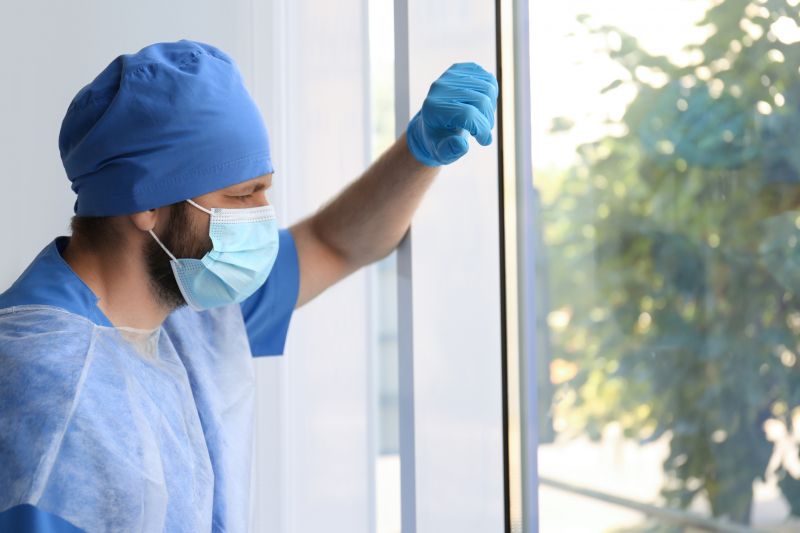Top Medical Facility Cleaning Products for Healthcare Environments
Discover essential cleaning supplies designed to maintain hygiene and safety in medical facilities efficiently.
 Maintaining a clean and sanitary environment in medical facilities is essential for patient safety and infection control. A comprehensive cleaning regimen involves a variety of products designed to target different surfaces and contaminants. These products often include disinfectants, surface cleaners, and specialized tools to ensure thorough sanitation. Selecting the right combination of cleaning supplies can help healthcare providers meet strict hygiene standards while minimizing the risk of cross-contamination.
Maintaining a clean and sanitary environment in medical facilities is essential for patient safety and infection control. A comprehensive cleaning regimen involves a variety of products designed to target different surfaces and contaminants. These products often include disinfectants, surface cleaners, and specialized tools to ensure thorough sanitation. Selecting the right combination of cleaning supplies can help healthcare providers meet strict hygiene standards while minimizing the risk of cross-contamination.
Top Overall Option
Multi-Purpose Disinfectant Solution
A versatile disinfectant solution that can be used on multiple surfaces, including countertops, equipment, and high-touch areas. It is designed to provide broad-spectrum antimicrobial activity with easy application methods, making it suitable for various cleaning routines in medical facilities.
Types of Products For Medical Facility Cleanings
Disinfectant Sprays
Aerosol or pump sprays for quick application on surfaces and equipment.
Surface Wipes
Pre-moistened wipes designed for disinfecting high-touch areas efficiently.
Floor Cleaners
Specialized solutions for cleaning and disinfecting floors in clinical environments.
Glass and Surface Cleaners
Products formulated for streak-free cleaning of glass, mirrors, and smooth surfaces.
Ultraviolet (UV) Sanitizers
Devices that use UV light to disinfect surfaces and equipment without chemicals.
Mops and Mop Solutions
Tools and solutions for deep cleaning large floor areas effectively.
Cleaning Cloths and Rags
Reusable microfiber cloths for wiping surfaces and equipment.
Biohazard Waste Bags
Specialized bags for safe disposal of contaminated materials.
Hand Sanitizer Dispensers
Automated or manual dispensers for promoting hand hygiene among staff and visitors.
Cleaning Brushes and Scrubbers
Tools for removing stubborn dirt and biofilms from surfaces and equipment.
Electrostatic Sprayers
Devices that evenly disperse disinfectant solutions over surfaces for comprehensive coverage.
Cleaning Carts
Portable carts equipped with compartments for organizing cleaning supplies and equipment.
Popular Choices
Convenient pre-moistened wipes for quick disinfection of high-touch surfaces.
Hand sanitizers with high alcohol content for effective hand hygiene.
Broad-spectrum disinfectants used for surface and equipment sanitation.
Portable UV sterilizers for quick surface disinfection without chemicals.
Efficient mops designed for deep cleaning and disinfecting floors.
Multi-surface sprays suitable for various hospital and clinic surfaces.
Essential for the safe containment and disposal of contaminated waste.
Popular for their ability to evenly coat surfaces with disinfectant solutions.
Reusable cloths that effectively trap dirt and microbes on surfaces.
Accessible stations to encourage hand hygiene among staff and visitors.
Effective cleaning products should be compatible with a range of surfaces found in medical settings, including stainless steel, plastic, and glass. They must also be easy to use, with clear instructions for proper application and contact time to ensure maximum efficacy. In addition, durability and storage considerations are important, especially in high-traffic areas where frequent cleaning is required. Proper training on product use is also crucial for staff to maintain consistent hygiene practices.
The variety of available products allows for tailored cleaning protocols suited to different areas within a healthcare facility. For instance, high-touch surfaces such as door handles and bed rails may require disinfectant wipes or sprays, while larger surfaces like floors and walls might need mops and cleaning solutions. Using a combination of products that are compatible and effective can help streamline cleaning routines and improve overall sanitation standards. Regularly updating cleaning supplies based on emerging guidelines and product innovations can further enhance infection prevention efforts.
Key Buying Considerations
- Compatibility with various surfaces in medical environments.
- Effectiveness against a broad range of pathogens and microbes.
- Ease of application and user-friendly instructions.
- Contact time required for disinfectants to be effective.
- Safety profile and potential toxicity of cleaning chemicals.
- Storage requirements and shelf life of products.
- Availability of ready-to-use formulations versus concentrated solutions.
- Compatibility with existing cleaning equipment and tools.
- Regulatory compliance and adherence to health standards.
- Cost-effectiveness for routine use in high-traffic areas.
- Ability to reach difficult or hard-to-access surfaces.
- Environmental considerations, if relevant (though not eco-focused here).
- Training requirements for staff on proper product use.
- Packaging size and convenience for storage and handling.
- Versatility for different cleaning tasks within the facility.
